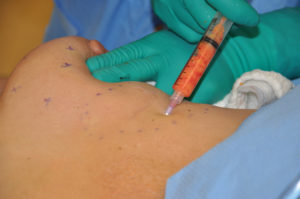Stem cells has understandably caught the imagination of both plastic surgeons and patients alike with their regenerative potential. This has led over the past few years to surgeons promoting their benefits to patients by so-called stem cell-enhanced or derived procedures. From facelifts to fat grafts, the moniker of the words ‘stem cells’ confers an improved method which leads to better or more long-lasting results. Such promotions have been done even though the FDA has not approved any stem cell therapies for cosmetic use.
Manufacturers of devices that can create stem cell concentrates have also emerged. This is usually done by taking fat obtained by liposuction, processing it through an on-site machine, and then a near immediate stem cell preparation obtained for patient re-introduction, usually by injection, is available. Laboratories also began offering services that will also take a patient’s fat, extract the stem cells, and grow them in cell culture to be available for use weeks later. The patient’s stem cells could also be stored and used in the future if desired.
Despite the initial tremendous enthusiasm and unregulated behavior when it comes to stem cell use, that has come to an abrupt end in the past year. The American Society of Plastic Surgeons and the American Society of Aesthetic Plastic Surgeons issued policy statements that their members should avoid offering and marketing stem cell procedures. This position is based on the scant human evidence in the medical literature to support the benefits of injecting stem cells into patients. While there may be real benefits to the use of stem cells, it is way too early to know what their actual benefits are, how they might work and what are the best indications for their use. Long-term controlled human studies need to be done for various plastic surgery indications to determine their efficacy…just like the approach used for drugs.
While plastic surgeons have been admonished by their own societies to cease stem cell therapies, the manufacturers and laboratories of stem cell-derived devices have received more stern edicts. Recent legal rulings have sided with the FDA that all companies processing stem cells or selling machines that extract and concentrate stem cells must do so through a formal FDA regulatory process involving controlled human clinical trials. There will no fast-tracking or short cutting to human use based on the comparative use of processing blood and blood-derived products. Basically the legal ruling is that fat is not blood and and large studies involving human participants is needed.

Dr. Barry Eppley
Indianapolis, Indiana


